2014 KIA Sportage radio antenna
[x] Cancel search: radio antennaPage 220 of 457
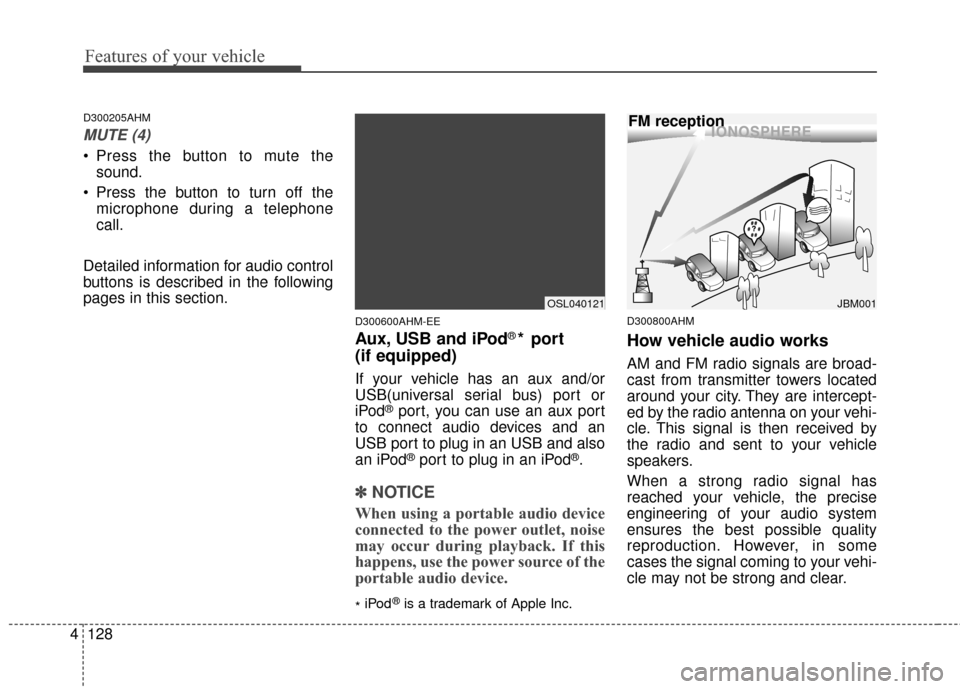
Features of your vehicle
128
4
D300205AHM
MUTE (4)
Press the button to mute the
sound.
Press the button to turn off the microphone during a telephone
call.
Detailed information for audio control
buttons is described in the following
pages in this section.
D300600AHM-EE
Aux, USB and iPod®* port
(if equipped)
If your vehicle has an aux and/or
USB(universal serial bus) port or
iPod
®port, you can use an aux port
to connect audio devices and an
USB port to plug in an USB and also
an iPod
®port to plug in an iPod®.
✽ ✽ NOTICE
When using a portable audio device
connected to the power outlet, noise
may occur during playback. If this
happens, use the power source of the
portable audio device.
*iPod®is a trademark of Apple Inc.
D300800AHM
How vehicle audio works
AM and FM radio signals are broad-
cast from transmitter towers located
around your city. They are intercept-
ed by the radio antenna on your vehi-
cle. This signal is then received by
the radio and sent to your vehicle
speakers.
When a strong radio signal has
reached your vehicle, the precise
engineering of your audio system
ensures the best possible quality
reproduction. However, in some
cases the signal coming to your vehi-
cle may not be strong and clear.
¢¢¢
JBM001
FM reception
OSL040121
Page 221 of 457
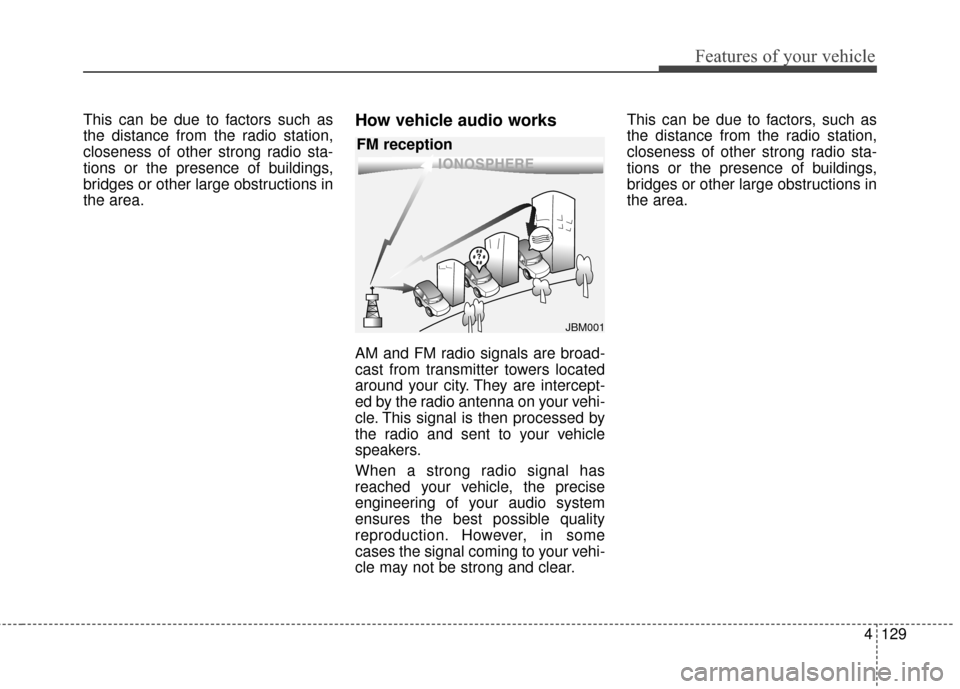
4129
Features of your vehicle
This can be due to factors such as
the distance from the radio station,
closeness of other strong radio sta-
tions or the presence of buildings,
bridges or other large obstructions in
the area.How vehicle audio works
AM and FM radio signals are broad-
cast from transmitter towers located
around your city. They are intercept-
ed by the radio antenna on your vehi-
cle. This signal is then processed by
the radio and sent to your vehicle
speakers.
When a strong radio signal has
reached your vehicle, the precise
engineering of your audio system
ensures the best possible quality
reproduction. However, in some
cases the signal coming to your vehi-
cle may not be strong and clear.This can be due to factors, such as
the distance from the radio station,
closeness of other strong radio sta-
tions or the presence of buildings,
bridges or other large obstructions in
the area.
¢¢¢
JBM001
FM reception
Page 223 of 457
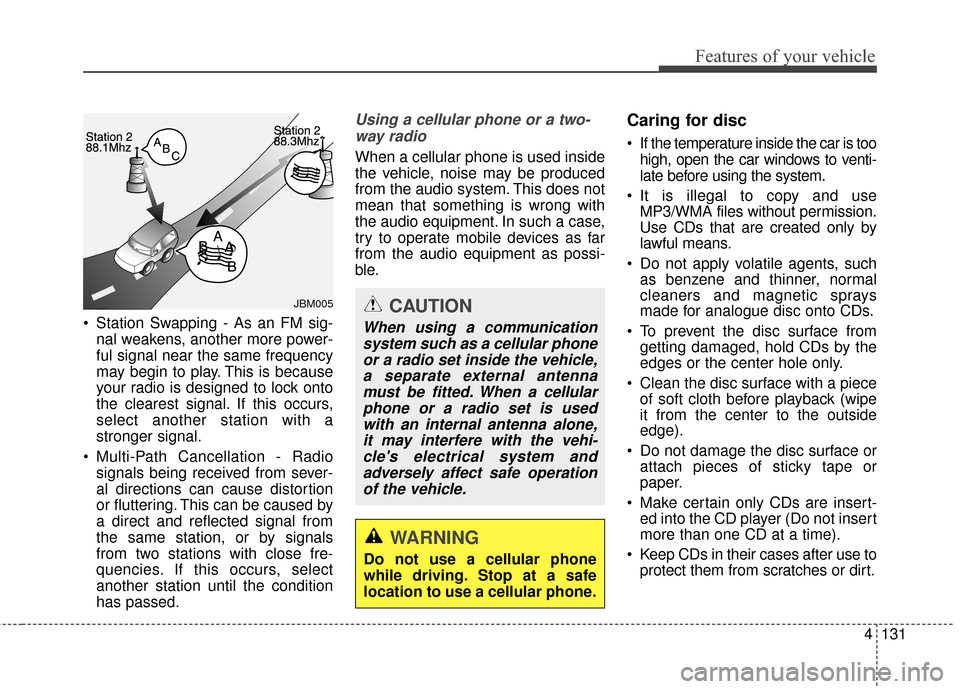
4131
Features of your vehicle
Station Swapping - As an FM sig-nal weakens, another more power-
ful signal near the same frequency
may begin to play. This is because
your radio is designed to lock onto
the clearest signal. If this occurs,
select another station with a
stronger signal.
Multi-Path Cancellation - Radio signals being received from sever-
al directions can cause distortion
or fluttering. This can be caused by
a direct and reflected signal from
the same station, or by signals
from two stations with close fre-
quencies. If this occurs, select
another station until the condition
has passed.
Using a cellular phone or a two-
way radio
When a cellular phone is used inside
the vehicle, noise may be produced
from the audio system. This does not
mean that something is wrong with
the audio equipment. In such a case,
try to operate mobile devices as far
from the audio equipment as possi-
ble.
Caring for disc
If the temperature inside the car is too high, open the car windows to venti-
late before using the system.
It is illegal to copy and use MP3/WMA files without permission.
Use CDs that are created only by
lawful means.
Do not apply volatile agents, such as benzene and thinner, normal
cleaners and magnetic sprays
made for analogue disc onto CDs.
To prevent the disc surface from getting damaged, hold CDs by the
edges or the center hole only.
Clean the disc surface with a piece of soft cloth before playback (wipe
it from the center to the outside
edge).
Do not damage the disc surface or attach pieces of sticky tape or
paper.
Make certain only CDs are insert- ed into the CD player (Do not insert
more than one CD at a time).
Keep CDs in their cases after use to protect them from scratches or dirt.
WARNING
Do not use a cellular phone
while driving. Stop at a safe
location to use a cellular phone.
JBM005CAUTION
When using a communication
system such as a cellular phoneor a radio set inside the vehicle,a separate external antennamust be fitted. When a cellularphone or a radio set is usedwith an internal antenna alone,it may interfere with the vehi-cle's electrical system andadversely affect safe operationof the vehicle.
Page 243 of 457
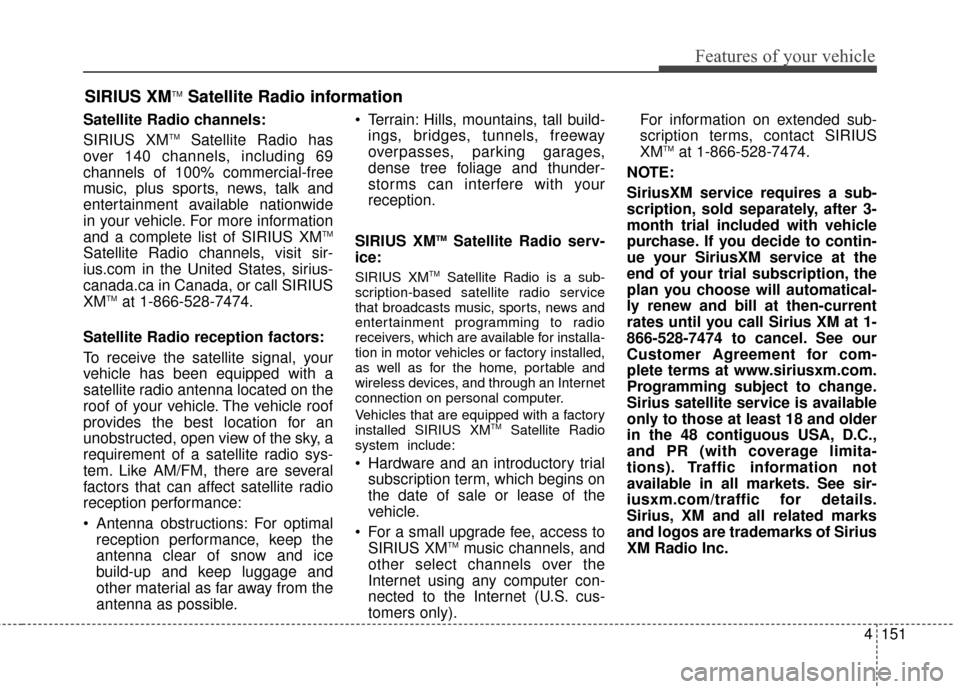
4151
Features of your vehicle
Satellite Radio channels:
SIRIUS XMTMSatellite Radio has
over 140 channels, including 69
channels of 100% commercial-free
music, plus sports, news, talk and
entertainment available nationwide
in your vehicle. For more information
and a complete list of SIRIUS XM
TM
Satellite Radio channels, visit sir-
ius.com in the United States, sirius-
canada.ca in Canada, or call SIRIUS
XM
TMat 1-866-528-7474.
Satellite Radio reception factors:
To receive the satellite signal, your
vehicle has been equipped with a
satellite radio antenna located on the
roof of your vehicle. The vehicle roof
provides the best location for an
unobstructed, open view of the sky, a
requirement of a satellite radio sys-
tem. Like AM/FM, there are several
factors that can affect satellite radio
reception performance:
Antenna obstructions: For optimal reception performance, keep the
antenna clear of snow and ice
build-up and keep luggage and
other material as far away from the
antenna as possible. Terrain: Hills, mountains, tall build-
ings, bridges, tunnels, freeway
overpasses, parking garages,
dense tree foliage and thunder-
storms can interfere with your
reception.
SIRIUS XM
TMSatellite Radio serv-
ice:
SIRIUS XMTMSatellite Radio is a sub-
scription-based satellite radio service
that broadcasts music, sports, news and
entertainment programming to radio
receivers, which are available for installa-
tion in motor vehicles or factory installed,
as well as for the home, portable and
wireless devices, and through an Internet
connection on personal computer.
Vehicles that are equipped with a factory
installed SIRIUS XM
TMSatellite Radio
system include:
Hardware and an introductory trial subscription term, which begins on
the date of sale or lease of the
vehicle.
For a small upgrade fee, access to SIRIUS XM
TMmusic channels, and
other select channels over the
Internet using any computer con-
nected to the Internet (U.S. cus-
tomers only). For information on extended sub-
scription terms, contact SIRIUS
XM
TMat 1-866-528-7474.
NOTE:
SiriusXM service requires a sub-
scription, sold separately, after 3-
month trial included with vehicle
purchase. If you decide to contin-
ue your SiriusXM service at the
end of your trial subscription, the
plan you choose will automatical-
ly renew and bill at then-current
rates until you call Sirius XM at 1-
866-528-7474 to cancel. See our
Customer Agreement for com-
plete terms at www.siriusxm.com.
Programming subject to change.
Sirius satellite service is available
only to those at least 18 and older
in the 48 contiguous USA, D.C.,
and PR (with coverage limita-
tions). Traffic information not
available in all markets. See sir-
iusxm.com/traffic for details.
Sirius, XM and all related marks
and logos are trademarks of Sirius
XM Radio Inc.
SIRIUS XMTMSatellite Radio information
Page 245 of 457
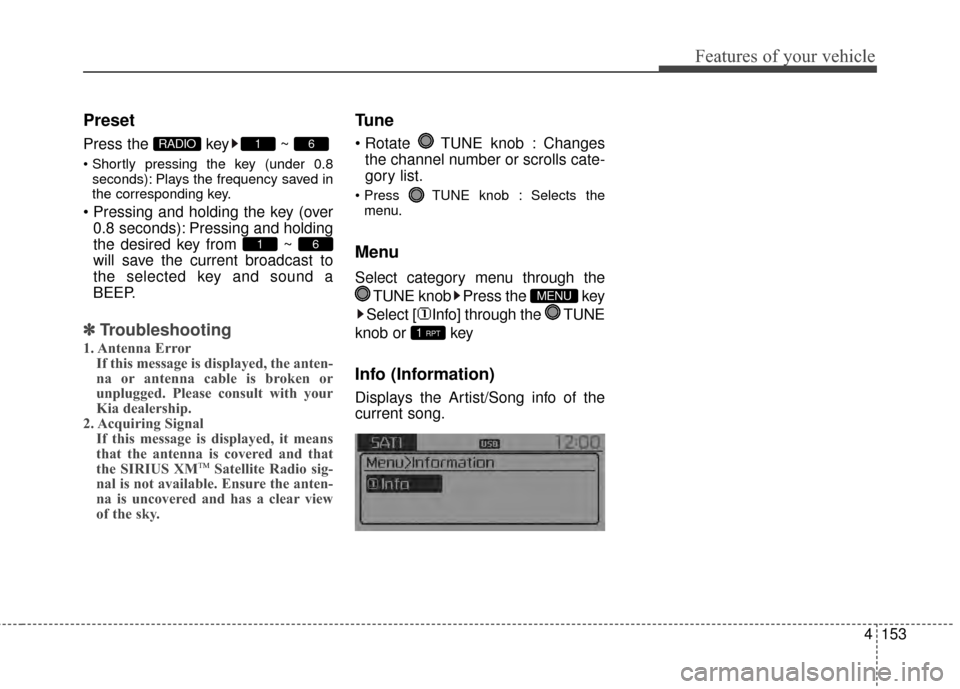
4153
Features of your vehicle
Preset
Press the key ~
seconds): Plays the frequency saved in
the corresponding key.
0.8 seconds): Pressing and holding
the desired key from ~
will save the current broadcast to
the selected key and sound a
BEEP.
✽ ✽ Troubleshooting
1. Antenna Error
If this message is displayed, the anten-
na or antenna cable is broken or
unplugged. Please consult with your
Kia dealership.
2. Acquiring Signal If this message is displayed, it means
that the antenna is covered and that
the SIRIUS XM
TMSatellite Radio sig-
nal is not available. Ensure the anten-
na is uncovered and has a clear view
of the sky.
Tune
TUNE knob : Changes
the channel number or scrolls cate-
gory list.
TUNE knob : Selects the
menu.
Menu
Select category menu through the
TUNE knob Press the key
Select [ Info] through the TUNE
knob or key
Info (Information)
Displays the Artist/Song info of the
current song.
1 RPT
MENU
61
61RADIO
Page 452 of 457
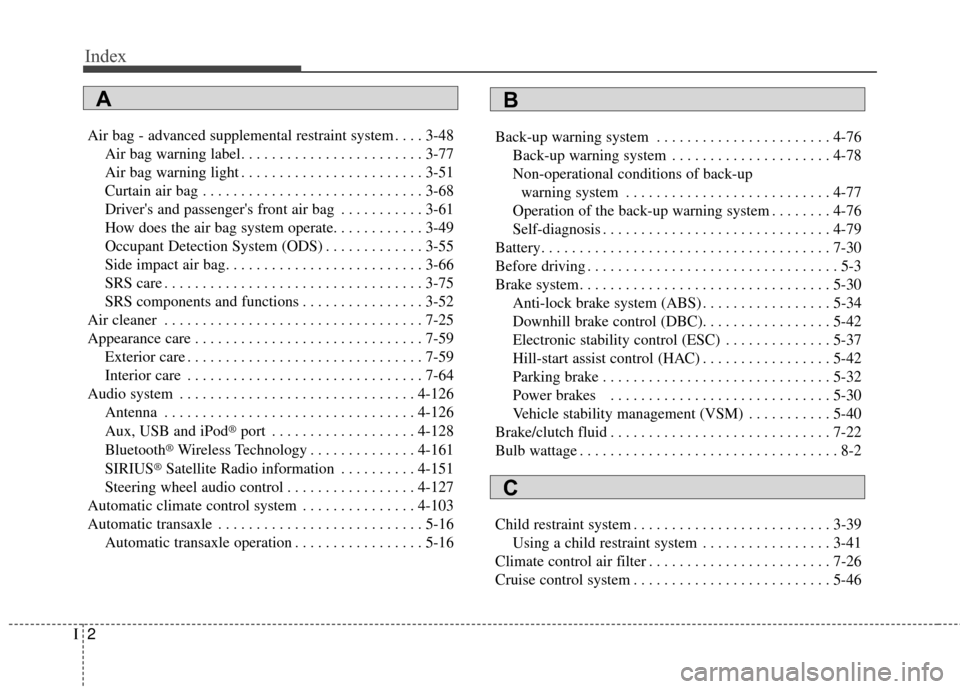
Index
2I
Air bag - advanced supplemental restraint system . . . . 3-48Air bag warning label. . . . . . . . . . . . . . . . . . . . . . . . 3-77
Air bag warning light . . . . . . . . . . . . . . . . . . . . . . . . 3-51
Curtain air bag . . . . . . . . . . . . . . . . . . . . . . . . . . . . . 3-68
Driver's and passenger's front air bag . . . . . . . . . . . 3-61
How does the air bag system operate. . . . . . . . . . . . 3-49
Occupant Detection System (ODS) . . . . . . . . . . . . . 3-55
Side impact air bag. . . . . . . . . . . . . . . . . . . . . . . . . . 3-66
SRS care . . . . . . . . . . . . . . . . . . . . . . . . . . . . . . . . . . 3-75\
SRS components and functions . . . . . . . . . . . . . . . . 3-52
Air cleaner . . . . . . . . . . . . . . . . . . . . . . . . . . . . . . . . . . 7-25\
Appearance care . . . . . . . . . . . . . . . . . . . . . . . . . . . . . . 7-59 Exterior care . . . . . . . . . . . . . . . . . . . . . . . . . . . . . . . 7-59
Interior care . . . . . . . . . . . . . . . . . . . . . . . . . . . . . . . 7-64
Audio system . . . . . . . . . . . . . . . . . . . . . . . . . . . . . . . 4-126 Antenna . . . . . . . . . . . . . . . . . . . . . . . . . . . . . . . . . 4-126
Aux, USB and iPod
®port . . . . . . . . . . . . . . . . . . . 4-128
Bluetooth®Wireless Technology . . . . . . . . . . . . . . 4-161
SIRIUS®Satellite Radio information . . . . . . . . . . 4-151
Steering wheel audio control . . . . . . . . . . . . . . . . . 4-127
Automatic climate control system . . . . . . . . . . . . . . . 4-103
Automatic transaxle . . . . . . . . . . . . . . . . . . . . . . . . . . . 5-16 Automatic transaxle operation . . . . . . . . . . . . . . . . . 5-16 Back-up warning system . . . . . . . . . . . . . . . . . . . . . . . 4-76
Back-up warning system . . . . . . . . . . . . . . . . . . . . . 4-78
Non-operational conditions of back-upwarning system . . . . . . . . . . . . . . . . . . . . . . . . . . . 4-77
Operation of the back-up warning system . . . . . . . . 4-76
Self-diagnosis . . . . . . . . . . . . . . . . . . . . . . . . . . . . . . 4-79
Battery. . . . . . . . . . . . . . . . . . . . . . . . . . . . . . . . . . . . \
. . 7-30
Before driving . . . . . . . . . . . . . . . . . . . . . . . . . . . . . . . . . 5-3
Brake system. . . . . . . . . . . . . . . . . . . . . . . . . . . . . . . . . 5-30 Anti-lock brake system (ABS) . . . . . . . . . . . . . . . . . 5-34
Downhill brake control (DBC). . . . . . . . . . . . . . . . . 5-42
Electronic stability control (ESC) . . . . . . . . . . . . . . 5-37
Hill-start assist control (HAC) . . . . . . . . . . . . . . . . . 5-42
Parking brake . . . . . . . . . . . . . . . . . . . . . . . . . . . . . . 5-32
Power brakes . . . . . . . . . . . . . . . . . . . . . . . . . . . . . 5-30
Vehicle stability management (VSM) . . . . . . . . . . . 5-40
Brake/clutch fluid . . . . . . . . . . . . . . . . . . . . . . . . . . . . . 7-22
Bulb wattage . . . . . . . . . . . . . . . . . . . . . . . . . . . . . . . . . . 8-2
Child restraint system . . . . . . . . . . . . . . . . . . . . . . . . . . 3-39 Using a child restraint system . . . . . . . . . . . . . . . . . 3-41
Climate control air filter . . . . . . . . . . . . . . . . . . . . . . . . 7-26
Cruise control system . . . . . . . . . . . . . . . . . . . . . . . . . . 5-46
AB
C